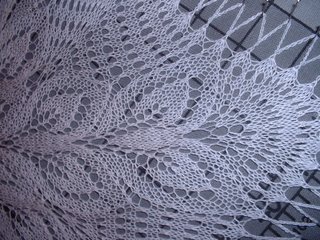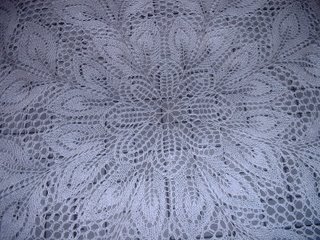For this table centre, I used a very fine cashmere/silk from Yubina. The thread is lovely, but very light. I would not use it again for a tablecloth, because it is so soft, and the points do not stay sharp after blocking. In fact, the entire cloth will need to reblocked and starched before I submit it to the California State Fair. I do like this thread, but it is more suitable for a diaphanous scarf or shawlette.
A few notes:
In the 0289/33 Anna magazine pattern, part of the chart is missing:
Row 79 - end with k2tog, yo, k4
Row 81 - end with yo, skp, k3
Row 83 - end with yo, k5
Row 85 - end with k6
The pattern in the Anna magazine is printed in several pieces: Rows 1-77, Rows 79-123, Rows 125-167, Rows 169-191, Rows 93-209, and Rows 211-245. The reprint is in fewer chunks, but it's also laid out differently.
In the reprint, the repeating stitches are more difficult to follow, because every stitch is shown in the chart, whereas in Anna the first grouping is shown, followed by the number of times to repeat. E.g.:
In Anna: [ 0,\ ] x7
In the reprint: [ 0, \, 0, \, 0, \, 0, \, 0, \, 0, \, 0, \ ]
If a smaller size doily is desired, stop after Row 132 or after Row 80.
 At Row 211, the 16 repeats are divided into 32 repeats. Add additional repeat markers at this point.
At Row 211, the 16 repeats are divided into 32 repeats. Add additional repeat markers at this point.Neither in the Anna magazine nor in the reprint is there a definitive process for crocheting off. For this doily, I used the following stitch groupings.
CROCHET BIND OFF: At beginning of Row 247, [K4] then crochet the number of sts indicated together, and ch13 in between each group:
7, 7, 5, 7, 7, 7, 5, 7, 7, 9
This last number (9) includes the last 5 sts of the repeat plus the first 4 of the next repeat.







 I switched to my blue
I switched to my blue 







































